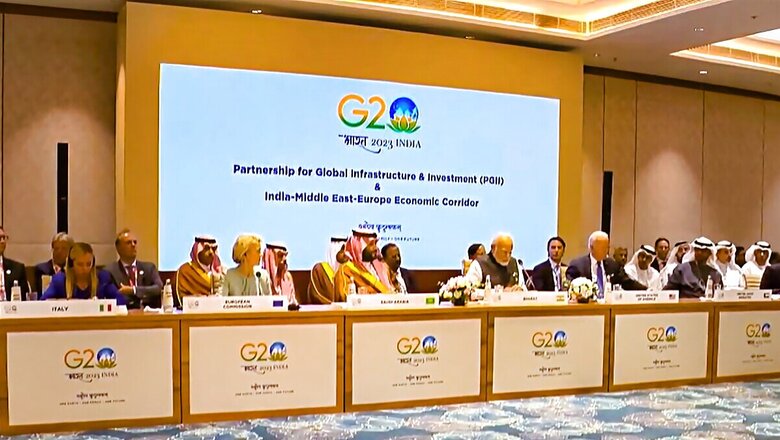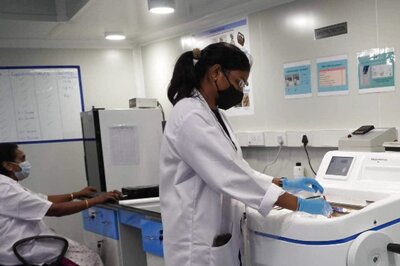
views
Is the India-Middle East-Europe Corridor (IMEC) the first significant step towards countering China’s Belt and Road Initiative (BRI) or ‘One Belt, One Road (OBOR)’ infrastructure project?
A massive infrastructure undertaking — involving India, the UAE, Saudi Arabia, the European Union, France, Italy, Germany, and the US as key stakeholders — the proposed corridor has the potential to reshape the economic destinies of not only the countries within its operational scope, but also other connected stakeholders, upon its completion.
Proposed to be linked through a rail and shipping network, the IMEC is expected to become a strategic tool in the global geopolitical landscape to challenge China’s growing dominance and its concealed credit system, which largely operates in the dark web, as China refrains from reporting it to the outside world and demands that borrowing countries follow suit. China critiques the democratic and Western civilisation-oriented systems while showcasing its own achievements, and Xi Jinping’s BRI is a reflection of this stance.
PARTNERSHIP FOR GLOBAL INFRASTRUCTURE INVESTMENT (PGII)
The proposed massive infrastructure development marks the first big initiative of the G7’s Partnership for Global Infrastructure Investment (PGII) initiative. The PGII initiative was formally launched on June 26, 2022, with the objective of creating a parallel network to counter China’s extensive BRI initiatives worldwide. The stated goal is to collectively mobilise $600 billion by 2027, with the United States taking sole responsibility for mobilising $200 billion over the next five years. Given China’s significant lending presence across the world, this $600 billion mobilisation target appears to be a promising start.
Presented as a transparent investment and lending platform rather than a coercive one, the PGII initiative pledges financial assistance to low- and middle-income countries for developing much-needed infrastructure to accelerate their economic growth. In return, it fosters a shift away from a China-centric bloc of nations, with a greater inclination toward democratic processes and the Western world system. Following the ongoing trade tensions between the United States and China, this initiative represents the next substantial move to isolate China. The PGII initiative can be viewed as the next dimension in the rivalry between the United States, Western nations, and China on the global stage.
According to the White House: “The PGICC will deliver transformative projects to bridge the infrastructure gap in developing countries, strengthen the global economy and supply chains, and advance US national security.”
TRACING THE IMEC
This substantial economic corridor is expected to be advantageous for low-, middle-, and high-income countries alike, focusing on economic integration among India, the world’s fastest-growing economy (with prospects of becoming the third-largest economy in the near future), the energy-rich Middle East, and prosperous Europe, achieved through the establishment of rail and shipping connectivity networks. It will serve as a market for all stakeholders.
The corridor will be divided into two segments. The first will connect India to West Asia or the Middle East, while the second will link West Asia to Europe. According to the memorandum of understanding (MOU): “It will include a rail line which, upon completion, will provide a reliable and cost-effective cross-border ship-to-rail transit network to complement the existing multimodal transport routes (maritime and road routes), enhancing trans-shipments of goods and services between South-East Asia through India to the Middle East and Europe.”
US President Joe Biden has referred to it as a game-changing development, while PM Modi has described it as a symbol of cooperation, innovation, and shared progress.
The PGII initiative is a direct challenge to China’s flagship BRI initiative.
BENEATH THE BRI
Coined and initiated by Chinese President Xi Jinping in 2013, the BRI initiative has, thus far, expanded to encompass 152 countries, involving agreements with numerous international organisations. Of these, 145 countries have signed MoUs with China for BRI implementation.
Through BRI, China aims to retrace the ancient Silk Route to connect with the outside world economically. Most of the countries that have joined BRI are from Sub-Saharan Africa, followed by Europe & Central Asia, East Asia & the Pacific, Latin America & the Caribbean, and the Middle East & North Africa. Additionally, six countries in South-East Asia are part of BRI, according to the ‘Green Finance & Development Center’.
Information from the Center indicates that 18 European Union (EU) countries and nine G20 countries are also engaged with the BRI platform. Italy, a member of both G7 and G20, initially joined the BRI initiative in 2019, but is now considering leaving it.
Under BRI, China has invested over $1 trillion in constructing or financing dams, rail lines, roads, ports, bridges, port-city projects and many other infrastructure projects. Geopolitically, the overarching goal of BRI appears to be imposing China’s worldview, primarily on low- and middle-income countries.
BRI VS PGII
Numerous BRI projects worldwide have faced negative publicity for various reasons. Many countries have fallen into a debt trap after being unable to repay Chinese loans. Pakistan uncovered corruption and overpricing in several BRI projects undertaken by Chinese companies during its 2020 investigation.
A World Bank report highlights that many large BRI projects expose countries and local communities to environmental and social risks. These risks include deforestation, water pollution, flooding, and droughts. Labour law violations, protests by local communities, and state heavy-handedness are frequently reported in connection with various BRI projects in different countries.
The PGII initiative promises the opposite. Its projects will be certified for ESG (environmental, social, and governance) risks-free and will be commercially viable, unlike many BRI projects. Projects such as the Gwadar Port in Pakistan, the Chinese-built port city in Sri Lanka, and many Bangladeshi BRI projects have raised concerns about white elephant projects.
The PGII initiative aims to create high-quality, transparently funded infrastructure projects in the future, in stark contrast to many BRI projects, where China primarily dominates the value chain. While China is often the sole funder and investor in many BRI projects, with details concealed, PGII initiatives are expected to generate funds transparently, with the funding process conducted openly.
Funding partners will involve stakeholder countries, other nations, multilateral agencies such as the World Bank, or private partners like Citigroup, Global Infrastructure Partners, or the Japan Foreign Trade Council. These projects will carry ESG risk-free certification and can attract private sector investment.




















Comments
0 comment